Massimo Marino's Blog: The Ramblings and the Rumblings, page 3
October 29, 2016
Getting Your Science Right
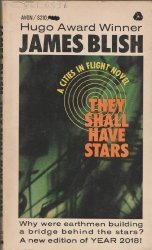 In James Blish’s novel “They Shall Have Stars
In James Blish’s novel “They Shall Have Stars ” we read:
” we read:
“there was no electronic device anywhere on the Bridge since it was impossible to maintain a vacuum on Jupiter.”
The assumption Blish made was that electronics implied vacuum tubes (no transistors invented yet), which would collapse under the extreme atmospheric pressure found on our giant planet companion.
Making assumptions – worse, making the wrong ones – will always let us down if we look to science fiction as a way to predict the future.
It helps if you really understand the science you use in your novels, its current limits, and its aspirations to venture beyond the edge. Don’t leave gray areas in the open, do your research and learn a lot about your science in science fiction, even if it is in order to write one line.
Definitions of science fiction grow on trees, and it is a great genre to write on, and to read. It certainly specializes in answering “What if?” questions. What other genre can place humans (or aliens) in an imagined scenario, dooms day, post-apocalyptic, dystopian societies, and with that element of science or technology to make the story unique and inspirational. It is the job of the writer to show how those human will then react.
For the writer, it is far more important to make sure for the follow-through of the initial “what if” to be realistic and logical than it is to make a clear prediction of scientific possibility, especially when your assumption – on the contrary – is that there will be no new scientific possibilities (like being stuck with vacuum tubes in the future). But don’t force prediction doing too much erring into fantasy. Current science – and currently explored theories – is a fertile ground for science fiction if you know where to look for.
More relevant than prediction is instead the influence of science fiction on real science. I’ve worked for many years at CERN and at the Lawrence Berkeley Lab, and I use that in my novels. Because science and science fiction are powerfully intertwined, it was also common to meet co-workers whose reading realm was Science Fiction. It’s obvious that science fiction is influenced by science, the clue’s in the name, but it is also true that science can be influenced by the right science fiction.
Take, for instance, robots. There is no doubt that many of the attempts to create humanoid robots have been driven by science fiction archetypes like Isaac Asimov’s classic stories. And the very word “robot” comes from fiction.
It is easy to find many different science and technology areas with a similarly complex relationship with science fiction. Virtual reality, tractor beams, bringing extinct creatures back to life, exoskeleton suits, cyborgs, cloaking devices and artificial intelligence spring to mind, and there are many more you can surely add to the list. But in the end, all of these pale before what might be the most important influence science fiction has on science. It may not have directly inspired every bit of science we see, but science fiction has certainly shaped generations of scientists. And that can only be a good thing.
Massimo Marino is a scientist envisioning science fiction. He spent years at CERN and The Lawrence Berkeley Lab followed by lead positions with Apple, Inc. and the World Economic Forum.
Massimo currently lives in France and crosses the border with Switzerland multiple times daily, although he is no smuggler.
As a scientist writing science fiction, he went from smashing particles at accelerators at SLAC and CERN to smashing words on a computer screen.
He’s the author of multi-awarded Daimones Trilogy, with over 1,000 ratings in combined Amazon and goodreads. He’s an active member of SFWA, Science Fiction & Fantasy Writers of America.
The Daimones Trilogy:
“Daimones” “Once Humans” “The Rise of the Phoenix”
• 2012 PRG Reviewer’s Choice Award Winner in Science Fiction
• 2013 Hall of Fame – Best in Science Fiction, Quality Reads UK Book Club
• 2013 PRG Reviewer’s Choice Award Winner in Science Fiction Series
• 2014 Finalist – Science Fiction – Indie Excellence Awards L.A.
• 2014 Award Winner – Science Fiction Honorable Mention – Readers’ Favorite Annual Awards
His novels are available from Amazon, Barnes & Noble (Nook), iTunes Apple Store, and many other retailers around the world.
Join his mailing list for new releases, or follow him on Facebook, Google+, and Twitter.
The post Getting Your Science Right appeared first on § A Scientist Envisioning Science Fiction.
Elements of Style
Narrative is a different kind of prose. It’s not journalism, and it has to render rather than report. O Tempora, o Mores, what is accepted today as good narrative prose is different from books and novels of the past. Flowery prose, pedantic descriptions, passive voices that were part of the accepted narrative styles of even half a century ago, are today seen as the mark of the debutant.
One of the things I learned—and that resonates as a mantra—is to ‘cull all unnecessary words.’ If you want to have a good start with style, read and digest The Elements of Style, Fourth Edition
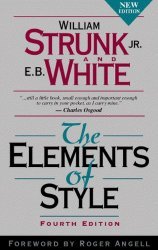

With “The Elements” in mind, what an independent author could do in order to make the life of editors and proofreaders better so that readers end up with a something that gives pleasure rather than headaches? Here’s a compendium of rule-of-thumbs that you might want to consider and apply.
ABBREVIATIONS & CAPITALIZATION
• Unless it is widely known to your readers (USA, UK, EU, UN) spell out the phrase or entity the first time you use it, with abbreviation in parentheses: The World Health Organization (WHO) was was established on 7 April 1948, headquartered in Geneva, Switzerland.
• There is no need for periods in abbreviations like those mentioned above.
• Avoid littering your text with acronyms and abbreviations. Note: Acronyms differ from abbreviations in that they read as a single words and often evoke meaning through spelling: Driving under the influence (DUI), Driving While Intoxicated (DWI) OR Auto-Immune Deficiency Syndrome (AIDS).
• Best not to capitalize whole words for emphasis (except when creating a style sheet). It reads like a SCREAM!
• Use capital letters to begin sentences, proper names, cities, nations, and the like.
• Titles & Rank– Avoid capitalization unless referring to a specific person: President Barack Obama landed in Havana. BUT The U.S. will soon have a new president.
ITALICS
Italicize foreign words not commonly understood: I love croissants. BUT For Mary, it was a nuit blanche.
Use italics sparingly for emphasis as good writing usually makes it clear where the emphasis falls: I could not not be there for the wedding.
Use italics for titles (plays, books, and major compositions): Handel’s Messiah OR Pamuk is the author of Snow.
DO NOT italicize proper nouns. Harvard University NOT Harvard University.
DO italicize abbreviations that would be italicized if spelled out: He likes the Journal of the American Medical Association (JAMA).
NUMBERS, DATES, TIME
• Spell out whole numbers from zero through one hundred and rounded-off multiples of these. Ex: thirty-two, one hundred nine thousand, fifty-four thousand, three hundred thousand.)
• If many numbers appear within the same paragraph or short text, use numerals, even if they should be spelled out according to the rule above.
• Use month-day-year dates: June 30, 1914 NOT 30 June 1914. Note that in text, a comma follows the year: When he was born on June 30, 1914, the world was on the brink of war.
• Spell our time of day in even, half, and quarter hours: We will resume at ten thirty. – Spell out numbers when “o’clock” is used: Her day begins at five o’clock in the morning.
• Use numerals & colons with exact times, using lowercase a.m. (ante meridiem) and p.m. (post meridiem) with periods: Her train leaves at 5:22 a.m. and mine at 7:00 p.m..
PUNCTUATION IN GENERAL
• Commas
A comma BEFORE “and” in a series (called the “serial comma”) helps to avoid ambiguity: He took a picture of Mary, John, and Susan. Use also if the last element includes “and”: They ate cheese, mustard, and bread and butter.
• Quotation Marks
Use double quotations for speech within text and place commas, periods, question marks, and exclamation points inside quotation marks: “I love you!” he shouted, OR Her eyes were “indigo,” as blue as the sea.
Double quotes may be used (sparingly please) to imply a satirical or atypical use of a word: After working in a dockside bar that summer, she considered herself “experienced” with the U.S. Navy.
Use double quotes for songs, poems, stories, paintings, and other short compositions: We all sang “God Save the Queen.” OR Mary Oliver’s best poem is “Wild Geese.”
Use single quotation marks for quoted material within quotations: “Why do you always say ‘ladies first’ before you open the door for me?” OR John said, “I love that poem ‘Wild Geese.’”
If your sentence ends with a quote, however, the final punctuation mark may fall outside the quotation marks, depending on usage: Why should we tolerate insults like “dumb blond”? OR I love that poem, “Wild Geese”!
• Colon vs Semi-colon
A colon says “note what follows.” Use with lists, to set a word/phrase apart, or to focus attention: His heart sank when he saw the sign: “Building Condemned.” – A semi-colon is like a joint (think of your knee or elbow) allowing separate-but-related elements to act as one: She had always wanted a water view; the river so near made it feel perfect.
• Hyphen, em-dash, and en-dash
Each serves a function:
Hyphens typically separate elements in adjectives where prefixes come into play: anti-abortion, pro-democracy, un-American.
When a comma does not create enough “breath” between clauses, the long em-dash helps by setting a related thought apart or giving it emphasis: She traveled to Australia—despite the cost—because it was her only chance to see her family.
The shorter “en-dash” connects dates and numbers: William Shakespeare (1564 –1616) OR “23–29”. (NOT 1564-1616 or “23-29”). Place lifespan dates in parentheses.
Hyphenate compound words when used as an adjective: James Baldwin was an African-American writer. But not when used as a noun: My friend is an African American. Another example: She loves eighteenth-century art while he finds the entire eighteenth century fascinating. Please note: We are living in the twenty-first century.
Hyphenate number compounds: She turns twenty-one today,OR The ninety-nine-year-old man won the race.
One word or hyphenate? When in doubt, use one word: multicultural NOT multi-cultural; email NOT e-mail.
• Suspension points
Use when a thought is unspoken/unfinished: “You know how I feel…”
PUNCTUATION IN DIALOGUE
If you choose to omit punctuation altogether or to indicate speech with am em-dash, please do this consistently. If you choose to use punctuation, you may follow these commonplace rules:
• Place spoken words within double quotes and with punctuation inside quotes: “Why now?” he asked.
• Use commas inside quotation marks to link speech interspersed with narration: “I really wish you’d stay longer,” she said, “because I’m not sure I can handle the pressure alone.”
• If you lead into spoken words with “that” then there should be NO COMMA BEFORE quotation marks: He finally told his brother that “You are no longer welcome in this house.”
• If your characters are well-drawn, there will be limited use for “he said,” “she replied,” and other such identifiers.
• If you choose to write in dialect, be consistent so that readers can “hear” the voice you aim to create.
Massimo Marino is a scientist envisioning science fiction. He spent years at CERN and The Lawrence Berkeley Lab followed by lead positions with Apple, Inc. and the World Economic Forum.
Massimo currently lives in France and crosses the border with Switzerland multiple times daily, although he is no smuggler.
As a scientist writing science fiction, he went from smashing particles at accelerators at SLAC and CERN to smashing words on a computer screen.
He’s the author of multi-awarded Daimones Trilogy, with over 1,000 ratings in combined Amazon and goodreads. He’s an active member of SFWA, Science Fiction & Fantasy Writers of America.
The Daimones Trilogy:
“Daimones” “Once Humans” “The Rise of the Phoenix”
• 2012 PRG Reviewer’s Choice Award Winner in Science Fiction
• 2013 Hall of Fame – Best in Science Fiction, Quality Reads UK Book Club
• 2013 PRG Reviewer’s Choice Award Winner in Science Fiction Series
• 2014 Finalist – Science Fiction – Indie Excellence Awards L.A.
• 2014 Award Winner – Science Fiction Honorable Mention – Readers’ Favorite Annual Awards
His novels are available from Amazon, Barnes & Noble (Nook), iTunes Apple Store, and many other retailers around the world.
Join his mailing list for new releases, or follow him on Facebook, Google+, and Twitter.
The post Elements of Style appeared first on § A Scientist Envisioning Science Fiction.
October 21, 2016
Who Will be Your Hero? – by Anne Conley

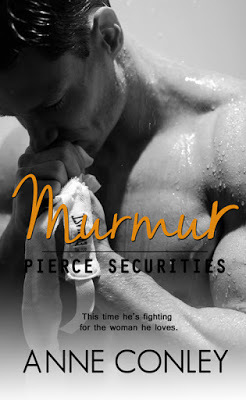

AVAILABLE ON AMAZON NOW!!
ONE-CLICK HERE
Synopsis
Valerie Dunaway is a former socialite who has hidden from the public eye for years, due to a horrific attack that left her scarred—physically and emotionally.
When a strange masked man makes himself at home with her, she’s unable to run. She calls the cops, but the agoraphobic won’t go into protective custody, so Detective Hollerman calls the only people he trusts: Pierce Securities.
Quinten Pierce is a Renaissance man—artist, lawyer, fighter—but his latest assignment has him losing his ever-present control. He’s got one fight left in his career, and although he can’t wait for it to be over, his opponent seems to have ties to Valerie, thus forcing him to hold on until he finds out exactly who he’s working with.
With the help of the Pierce team, the scarred princess and the gentle giant must silence the murmurs of the past that threaten their future.

EXCERPT
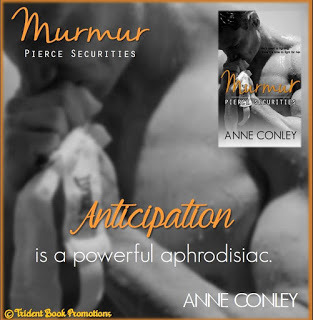
They worked side by side for hours, with Quinten doing periodic checks through her quarters. Her mask continuously slipped, and Valerie continuously adjusted it. She was working on smaller, detailed pieces of her bird houses, making little shutters for the window holes, and the small reciprocating saw she used was difficult to see through the eye holes. Finally, Quinten had enough.
He’d cut all his pieces and ground the edges smooth and had begun taping them to solder together. But he finally stopped with a sigh.
“Do you have to wear the mask? Valerie, I’ve seen you. It’s obvious you don’t typically work with it, and you’re liable to hurt yourself because you’re limiting your vision with it on.” He took a step closer, and she stiffened, so he froze, looking at her eyes through the holes of her mask. “You’re fucking stunning. With or without it. Just take it off,” he said quietly, then held his breath.
She was a bird again, ready to take off in flight at any moment. He longed to yank it off her face and bury his mouth in the softness of her lips, but he relegated that thought to imagination only. Her eyes darted around wildly, and her hands twisted in front of her. She waged an inner war, and Quinten had no idea what was happening inside her head.
“It’s just us,” he reiterated. “I won’t even tell anybody if you don’t want.” Lowering his voice, he reminded her, “I’ve seen you without it.”
Her mask today was the purple one, and it went with the lavender swirly patterns in the long dress she wore. Her fingers trembled as she reached for it and slowly peeled it off her face, inch by inch. When she had it off, her eyes were closed as it dropped to the ground.
Quinten took a step closer, his eyes gazing at her mouth, plump and lush and utterly kissable.
“Look at me, Valerie.”
Painfully slowly, she opened her eyes, and they made a tortuous path up his body before landing on his face.
Quinten tried fisting his hands at his sides. He tried to shove them in his pockets. He tried putting them behind his back. But they wouldn’t mind him. Instead, they traveled to her head, cupping her cheek with one palm and her neck with the other. His thumb traced her bottom lip, and her tongue snaked out to wet it.
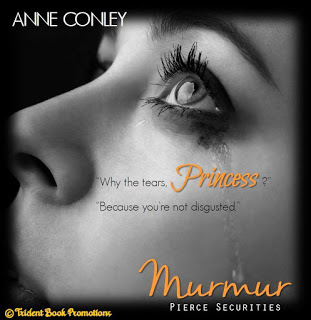 Valerie’s eyes were the greenest of green, like Caribbean pools at the base of waterfalls you saw in magazines. They watered with uncertainty, and Quinten would have done anything to reassure her.
Valerie’s eyes were the greenest of green, like Caribbean pools at the base of waterfalls you saw in magazines. They watered with uncertainty, and Quinten would have done anything to reassure her.“Fucking stunning.”
She let out a wild sob and grabbed the front of his shirt, yanking him toward her. So he kissed her. And promptly lost his mind.
Her lips were so soft and warm, and as soon as they touched, she let out a sobbing cry. Instinctively, Quinten knew she needed him to show her exactly how beautiful she really was.
He could only imagine her life up until now—only being worthy because of her beauty and then having her perception of that beauty taken away in such a horrific way. So horrific, she felt she deserved to be shut away from the public eye when she was used to being in the public eye at all times.
So Quinten kissed her for all he was worth. It began with a melding of lips, just tasting her sweetness against his lips. Then he tickled her lips with his tongue and when she opened, he swooped in.
It was dizzying, the way she tasted—so fucking sweet. He grounded himself by pressing his body against hers, pushing her up against the workbench, but it wasn’t enough.
He would never get enough.
He tangled one hand in her blonde locks while the other went around her waist and pressed her fully against him. It was tacky, but he pressed his erection into her hip because he needed her to see somebody wanted her. Desired her.
Needed her.
His lips were wet with her tears, and Quinten wanted her to tell him why she was crying. He needed her honesty—with him as much as herself. He broke the kiss and leaned his forehead against hers, looking into the depths of her green eyes.
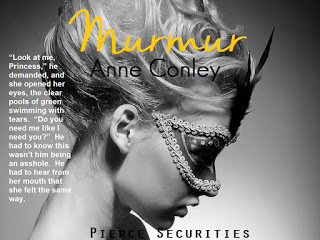 “Why the tears, Princess?”
“Why the tears, Princess?”She laughed but sobbed at the same time, and he used his thumb to wipe the track down her face.
“Because you’re not disgusted.”
Had someone told her she was disgusting? That right there broke Quinten’s heart, and all thoughts of waiting until this was over evaporated in one lust-hazed instant.
“Let’s go back to your bed, and I’ll show you just how not disgusting you are.”
Read other stand-alone novels in the Pierce Securities Series:
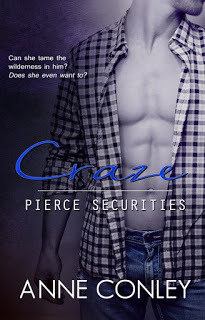
Craze (Book 1)

Wire (Book 2)

Click (Book 3)
READ CHARITABLY!
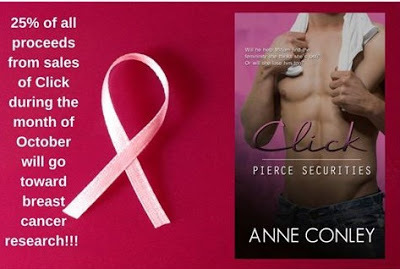
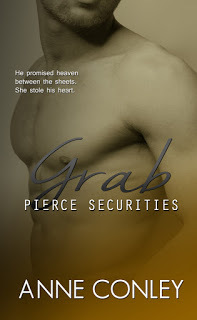
Grab (Book 4)
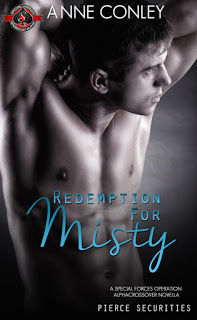
Redemption for Misty (Book 4.5)
“Have you read The Book B!tches, yet?”
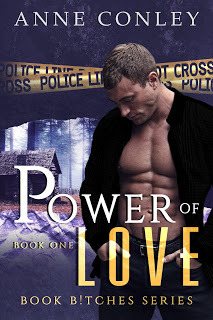
Power of Love (Book B!tches #1)
Follow Anne here:
anneconleyauthor@gmail.com
www.anneconley.com
www.facebook.com/anneconleyauthor
https://www.pinterest.com/anneconley/
@anneconley10
FREE Novels!
Contemporary Romance:
Neighborly Complications
Amazon
iTunes
Barnes and Noble
Kobo
Paranormal Romance:
Falling for Heaven
Amazon
Barnes and Noble
Smashwords
Kobo
ABOUT THE AUTHOR

Anne has written her entire life and has the boxes of angst-filled journals and poetry to prove it. She’s been writing for public consumption for the past several years. Currently, she has four romance series. In Stories of Serendipity, she explores real people living real lives in small town Texas in a contemporary romance setting. In The Four Winds, she chronicles God’s four closest archangels, Uriel, Gabriel, Raphael, and Michael, falling in love and becoming human. In Pierce Securities, she gives us Ryan, Evan, Miriam, Zack, Quinten, and Simon. Her newest series, Book B!tches, is all about a group of women in Mystic, Texas who get into all sorts of shenanigans. She lives in rural East Texas with her husband and children in her own private oasis, where she prides herself in her complete lack of social skills, choosing instead to live with the people inside her head.
The post Who Will be Your Hero? – by Anne Conley appeared first on § A Scientist Envisioning Science Fiction.
September 25, 2016
The Jerk
Instead of gazing into the mirror, turn away from the mirror and notice the colors in which the world seems to be painted. Are you surrounded by fools and gray non-entities, by people with bad taste and silly desires, by boring people undeserving of your attention, by people who can be understood quickly by applying a broad and negative brush—creeps, wackos, stuck-up snobs, bubbleheaded party kids, smug assholes, and, indeed, jerks?
If this is how the world regularly looks to you, then I have bad news: Likely, you are the jerk.
This is not how the world looks to most people, and it is not how the world actually is. You have a distorted vision. You are not seeing the individuality and potential of the people around you.
Needless to say, most politicians and "successful" people believe they are surrounded by asses.
September 24, 2016
Enjoy Florida’s Hotels in Fort Meyers, Panama City, Gainesville and More
The post below was originally published on Leah Travels on September 9, 2016, by Leah Walker.
Florida is always better in fall. The sticky days of summer have passed, the crowds are headed home, and hotels are offering huge discounts to lure in travelers for the shoulder season. Florida sees average highs between 75 and 90 degrees in September, October, and November, which means you can squeeze at least three more months out of summer. Whether you’re headed to Florida for the uncrowded beaches, discounted attractions, or fall sports games, these five cities offer the most bang for your buck this time of year.
Panama City
Florida is always better in fall. The sticky days of summer have passed, the crowds are headed home, and hotels are offering huge discounts to lure in travelers for the shoulder season. Florida sees average highs between 75 and 90 degrees in September, October, and November, which means you can squeeze at least three more months out of summer. Whether you’re headed to Florida for the uncrowded beaches, discounted attractions, or fall sports games, these five cities offer the most bang for your buck this time of year.
Panama City, Fla., is the ultimate city by the sea. Visitors can enjoy all of the perks of city life, like specialty shops, historic sites, nonstop nightlife, and world-renowned eateries, while enjoying affordable accommodations in the heart of town or at nearby beaches. Stay steps from the sea for an unbelievably low fall price at the Long Beach Resort by Funquest Properties in Panama City Beach or just over the bridge at the Suburban Extended Stay Hotel in Panama City.
Fort Myers Beach
Know for its sugary sands and crystal clear Gulf of Mexico waters, Fort Myers Beachis even more picturesque when the droves of tourists have left for the season. However, the tourists heading back to school and work doesn’t mean the seaside town shuts down. Visitors can still enjoy dolphin eco-tours, parasailing, fishing, and combing the seven miles of fine white sand. Affordable oceanfront accommodations like the Neptune Resort are much easier to find in fall, leaving you more money to spend on fresh-caught seafood and souvenirs.
Gainesville
Gainesville comes to life in September, and the Gators fans don’t stop cheering until the season ends. There’s no doubt you should catch a game at the University of Florida’s Ben Hill Griffin Stadium during your fall visit, but Gainesville offers far more than football. Visitors can kayak and fish on nearby lakes, hike, shop the downtown farmers market, browse boutiques, taste local craft beers, and dine at the college town’s legendary restaurants. Stay in the heart of the Gators action for a budget-friendly price at the Holiday Inn Gainesville University Center or Days Inn Gainesville University.
Jacksonville
Jacksonville is Florida’s largest city, but its size shouldn’t scare you away. World-renowned beaches can be found minutes from the bustling downtown area, which comes even more alive during the NFL football season. Jax, as it’s known among locals, is one of few places in Florida where you can enjoy the perks of a big city vacation and the sand and sea for an affordable price. Look to Homewood Suites by Hilton for a good value and better location.
Treasure Island
Southwestern Florida is as stunning as it sounds, and so is picture-perfect Treasure Island. The oceanside town is located on a peninsula west of bustling Tampa, which means the city’s favorite attractions (like Busch Gardens and the Florida Aquarium) are less than a one-hour drive from your luxurious seaside retreat. Fall is the best time to find unbeatable deals in tropical Treasure Island, as the hordes of summer tourists leave lavish resorts like Bilmar Beach Resort nearly empty.
The post Enjoy Florida’s Hotels in Fort Meyers, Panama City, Gainesville and More appeared first on § A Scientist Envisioning Science Fiction.
Visit the City of Chicago and Stay in Rosemont, IL
The post below was first published on English Blog Montenegro.com August 2, 2016 by Montenegro blogger
Rosemont, Illinois has all the characteristics of a small community, but due to its excellent location, which means only five minutes from O’Hare Airport and twenty minutes from Chicago’s downtown, the place earned the reputation of a flourishing touristic and commercial place. Attractions in Rosemont such as the Donald E. Stephens Convention Center, the Allstate Arena, Rosemont Theatre, the amusing district MB Financial Park, the new Fashion Outlets of Chicago, as well as extensive array of hotels and excellent restaurants accommodates 75,000 visitors on a daily basis. Hotels, like Chicago Marriott Suites O’Hare and Hilton Rosemont Chicago O’Hare, offer special deals on rooms starting from $79 per night. Why waste your time in traffic when you can be accommodated right next to major attractions like The Rosemont Theater, and for a competitive price?
 Image via Flickr by Michel Curi
Image via Flickr by Michel Curi
The Adventurous City of Troy, MI
Troy is known for a considerable number of summer camps and outdoor activities for all ages. Also, it is an attractive business district since many large companies like Bank of America, The Woodbridge Company, and SAE International have their central office here. Weekdays are the most requested period, and for obtaining a good price for hotel accommodation it is recommended to plan your trip ahead. The Courtyard by Marriott Detroit Troy and The Met Troy are always a good choice.
 Image via Flickr by Dave Hogg
Image via Flickr by Dave Hogg
Outstanding Kansas City, MO
As the largest city in Missouri, Kansas City has plenty of available accommodations for every budget. The rich history of this town makes you want to explore all of the areas, from farmers’ markets to the Vine District, as well as the Spanish-styled architecture and upscale shops of the Country Club Plaza in the south. Best months for visiting Kansas City, due to outstanding deals, are from January to May or in October. We recommend places like the Capri Motel Kansas City northeast of downtown or America’s Best Value Inn and Suites Kansas City Downtown.
 Image via Flickr by Brian Hillegas
Image via Flickr by Brian Hillegas
Check Arrangements in Grand Forks, ND
Planning a trip to Grand Forks can be effortless if you know which hotel offers fantastic prices. Occasions for traveling in Grand Forks are various because this town is known for sports events, business, recreational activities, and concerts. In Econo Lodge Grand Forks and Red Roof Inn TownHouse – expect to find enjoyable rooms from only $43 per night. For a more upscale experience, check accomadtions at the Staybridge Suites. Hotels like Marriott Grand Forks and Holiday Inn Express Hotel & Suites Gran give breezy arrangements from a starting price of only $79.
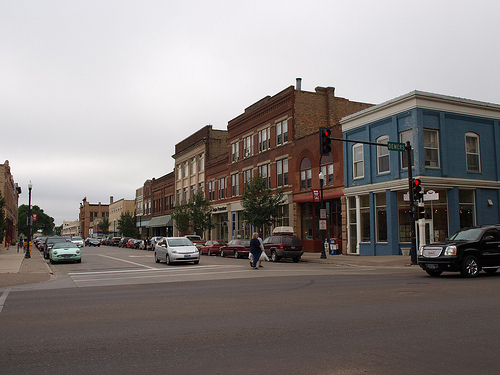 Image via Flickr by Victory & Reseda
Image via Flickr by Victory & Reseda
The Fascinating Town of Columbus, OH
To experience the fascinating town of Columbus, in the best way possible and on a budget, choosing hotels in the center or close to fun attractions is a must. This city offers an abundance of suitable and modern accommodations at convenient locations. There are a variety of interesting things to apprise and explore here, starting from the famous Scioto Mile Fountain that was pronounced one of the world’s 15 most astonishing fountains. Also, another impressive thing to see is the Arch at McFerson Commons, which is a 100-foot red metal art sculpture. We also recommend visiting the historic German Village, or if you are a foodie, savor Katalina’s famous pancake balls or Harvest Pizzaria’s wood-fired pizzas. Hotels like The Courtyard by Marriott Easton-Columbus and The Blackwell offer proper balance of quality and price.
 Image via Flickr by jpmueller99
Image via Flickr by jpmueller99
The post Visit the City of Chicago and Stay in Rosemont, IL appeared first on § A Scientist Envisioning Science Fiction.
September 22, 2016
Hipmunk Hotels: Find Comfort in Wheeling, Newport, Norfolk and More!

The post below was originally published on Nomad Chick on August 10th 2016 by Jeannie Mark.
It’s that time of year to travel and a staycation is a great way to save money, but still have a satisfying trip.
If you live in the northeastern part of the states, take a chance on some off-beaten places you might otherwise ignore.
They are less busy, have hidden gems, and are usually has something for every family member, children included.
Enjoy this guide to what to do and where to stay along the northeast:
SpringHill Suites in Wheeling, West Virgina
West Virginia is a state full of history and natural beauty. Take a stroll through Oglebay Park or get a picture view of the suspension bridge, built in 1849. The most comfortable hotel is SpringHill Suties because it really caters to your needs. With a full service snack bar, indoor pool, spa, and fitness center, it really is a perfect home away from home.
Ambassador Inn & Suites in Newport, Rhode Island
Picturesque Rhode Island evokes ocean views and a calmer life (with a dash of luxury thrown in). One of the most beautiful drives you will ever experience is along Ocean Drive. And if you want to fit in a slew of historical sites and buildings, consider taking a historic tour. For cozy accommodations, the Ambassador Inn & Suites will be perfect for you. Savor a free breakfast and use free WiFi to plan your day. After you return from sightseeing, take a dip in the outdoor pool and then sink into your king-sized bed.
The Melrose Georgetown Hotel in Alexandria, Virginia
Just located outside of D.C., Alexandria is a quaint destination with fascinating historic tones. Don’t miss the Christ Church, Carlyle House, and the George Washington Masonic National Memorial. Since you’re taking a walk down history, why not stay at the Melrose Georgetown Hotel. Right in the heart of everything you’d want to be near (including the JFK Center), enjoy fluffy duvets, brocade love seats, and all the amenities, like room service or the hotel restaurant.
Aloft Chesapeake in Norfolk, Virgina
Norfolk really has a lot of treats and shouldn’t be overlooked. The MacArthur Memorial is a must-see, along with Harbour Park. Those two are a great mix of nature and architecture. A terrific place to rest your head is atAloft Chesapeake, a charming hotel that’s loft inspired and pet friendly. Share a meal in the café and an exercise session in the fitness room together.
Hotel Bethlehem in Bethlehem, Pennsylvania
A city with interesting history, you’ll enjoy what Bethlehem has to offer. Book a tour at the Burnside Plantation, to learn how a plantation operated. Another fun activity is to do a walking tour of the town and take in some sites at an easygoing pace. For that final touch of antique, stay at Hotel Bethlehem. Built in 1922, it’s a mix of colonial style with modern flair. Photograph the grand lobby with its Palladian windows as you make your way to two choices of restaurants. All the comforts are there!
I’m a regular writer for Hipmunk. Check out my other articles for them on this blog.
Photo courtesy of Nenna via Trover
The post Hipmunk Hotels: Find Comfort in Wheeling, Newport, Norfolk and More! appeared first on § A Scientist Envisioning Science Fiction.
September 12, 2016
How to Pack
Traveling for a marathon? Great! Not only is training for and running a marathon its own reward, but choosing to attend a destination race is a great excuse to travel to new places.
There’s just one caveat: It can be easy to let pre-race jitters cause you to lose focus and forget critical gear. If you want to avoid feeling unprepared at the starting line, simply refer to this handy checklist whenever you’re preparing for a non-local race.
In addition to your usual running staples—including (but certainly not limited to) running shoes, a fuel belt, a GPS watch, hair ties or a headband, and so on—here’s what to keep in mind when packing for a destination marathon.

Squeeze it All in a Carry-On
You know the panic that sets in upon arriving at baggage claim and realizing your bag has been lost? Imagine how much worse it is when said bag contained your running shoes and marathon gear. Avoid this agony by packing everything into a carry-on. If you must check a bag with extra clothing and accessories, at the very least make sure that your race-day essentials stay with you at all times.
Pack Layers
No matter where you’re going, it’s smart to pack for all kinds of weather. Temperatures can swing wildly between the start of a race and its end, particularly when you’re starting out early in the morning or running at high elevations. And then, of course, there’s the ever-present risk of rain, wind, intense sun, and freak weather events. Prepare for it all by bringing along a variety of layers, a running hat, gloves, sunglasses, a racing jacket and tights, and so on. This is particularly important if you’re traveling to a climate that’s different from the one in which you’ve trained (say, from New York to Colorado or from Australia to NYC). Since your body won’t be adjusted to that climate, weather changes may feel more extreme. It’s important to have the right apparel on hand so you can be as comfortable as possible. While you’re at it, go ahead and pack a back-up base outfitfor race day—that way you’ll be covered in case anything gets wet or ripped.
Dress to Compress
Regardless of whether you’re traveling via air or car, it’s a smart idea to wear compression socks during the trip. Doing so will help reduce swelling and prevent blood from pooling in your lower legs while you sit for extended time periods. (For the same reason, it’s also a good idea to stand up and walk around at least once every hour.) Helping your blood circulate properly in transit will ensure that your legs don’t feel like deadweights on race day.
Pack Healthy Snacks
Rest stops and airplanes aren’t exactly known for their healthy fare. If you’re concerned about pre-race nutrition (and you probably should be), it’s a good idea tobring along your own healthy snacks to consume in transit. Also pack your own energy gels and other snacks if you’re wedded to particular brands—if you’re traveling across state or country lines, there’s no guarantee that you’ll be able to find your favorite brand(s) once you reach your destination. And remember to bring along a water bottle—staying hydrated is critical if you want to feel energized on race day.
Be Kind to Your Skin
Marathons require runners to physically exert themselves outside for multiple hours—so it’s important to pack some sunscreen. Not only will it keep your skin healthier, but it will also spare you from having to add “sunburn” to your list of aches and pains the day after the race. Many runners also swear by Body Glide as a means of reducing skin friction during the race and minimizing pain and discomfort after it.
Stock a Post-Race Recovery Kit
While it’s most critical to pack essentials for the actual marathon, it’s also important to think about what you’ll need once the race is done. Put together a post-race kitthat includes flip flops (or other comfy shoes), clean socks, an extra outfit, warm layers, snacks, face wipes and/or a towel, and a first aid kit.
Consider Entertainment
Before traveling, put together a playlist(s) that you can listen to both during your travels and before or during your race. Listening to music or podcasts is a great way to pass the time while you’re traveling and soothe any jitters leading up to the race.
Utilize Plastic Bags
Given all the gels and fluids that most marathoners are wont to carry with them, it’s a good idea to make plastic bags your new best friend for the duration of your trip. Store your cell phone in a sandwich bag, and bring along a few extras in case that one is the victim of exploding energy gels. It’s also a good idea to pack your post-race clothes in gallon-size Ziplocs—then, come race day, you can look forward to changing into a dry pair of clothes no matter the weather.

Plan to Recharge
These days, many runners choose to use a Garmin, GPS watch, iPod, smartphone, or other technological accoutrement while running. If you’re in this camp, then it’s important to remember to pack the respective chargers for all of this gear. If you’re traveling abroad, keep in mind that power sources and plugs will probably be different than in the US—stock up on adaptors prior to leaving the country.
Bring the Right Paperwork
If you’ve been issued a race form, waiver, bib, and/or chip in advance of the race, remember to stash these in your carry-on. You may also want to bring along proof of time (if you’re hoping to move up in the corrals), pace charts, and your travel itinerary. If you’re traveling internationally, don’t forget your passport and any necessary visas.
Once you’ve accounted for everything on this list, it’s time to sit back, breathe, and rest easy. You’ll have everything you need for your race. Now all you need to focus on is getting across the finish line.
Start Planning Your Marathon Travel
The post How to Pack appeared first on § A Scientist Envisioning Science Fiction.
How to Avoid Getting Sick

This post was originally published on Hipmunk’s Tailwind Blog on Jan 22 2016 by TheHipmunk
Forget snakes on a plane. Worry about the germs. Research shows that air travelers are at a higher risk for infection than people going about their daily lives.
Just how are illnesses spread on a plane? It comes down to two main factors: Airborne germs that are easily inhaled by people sitting in close quarters, or contact with germ-riddled surfaces on the plane. These factors are exacerbated by the dry conditions typical of airplanes, because viruses prefer low-humidity environments.
The good news is that, for the most part, airplanes’ air filtration systems function well enough that you’re unlikely to contract more serious illnesses. Instead, your greatest risk is contracting the common cold or a classic case of the flu.
While that’s all well and good, it may be little comfort to people who don’t particularly want to have a cold or the flu while trying to enjoy their vacation. Luckily, it is possible to decrease your risk of infection from germs on a plane. Here’s how to maximize the chances of disembarking the plane as healthy as you boarded it.
Don’t travel if you’re already sick.
If you know that you’re suffering from a contagious illness, do your immune system (and your fellow passengers) a favor and don’t expose yourself to any more germs by boarding a plane. In particular, the CDC advises that people avoid plane travel if you’re more than 36 weeks pregnant, have recently had surgery, have had a recent (serious) injury, or have a fever. In each of these cases, you’ll be traveling with a compromised immune system, which increases your risk of catching a contagious infection. Some airlines may be lenient with rescheduling fees if you can prove that you’re sick; contact the airline to discuss your options.

Ask to switch seats.
If you find yourself beside someone who’s hacking or sniffling, it’s okay (really!) to ask a flight attendant if it’s possible to switch seats. Even moving just a few rows away can help protect you from a sick person’s germs. If there are no other seats on the plane, donning a face mask might help.
Wipe down germy surfaces.
Tray tables, armrests, and seat-back pockets are consistently found to be some of thegermiest parts of a plane. Minimize contact with these germs by using wet wipes to disinfect tray tables, armrests, and seat-back pockets and/or using hand sanitizer after touching any of these surfaces.
Wash your hands (a lot).
For the most part, your hands are your body’s primary point of contact with germy surfaces. Those germs (including cold and flu viruses) can survive on your skin for hours. The simple fix? Wash your hands frequently with soap and water or (in a pinch) with an alcohol-based hand sanitizer.
Keep air vents open.
Circulating air is key to preventing the spread of illness on a plane, so keep the air vent above you open. And don’t worry—the air pumping through the vent is filtered and safe to breathe.
Bring your own blanket and pillow.
A Wall Street Journal investigation found that airlines tend to wash their blankets and pillows only every 5 to 30 days. (Yes, you read that right.) This means that when you borrow a blanket from the airline, you’re sharing a whole lot of germs. Avoid the issue entirely by bringing along your own travel blanket and pillow.
Close the toilet seat before you flush.
The spray that accompanies flushing spreads germs throughout the airplane bathroom; closing the lid before you flush will help you avoid contact with these nasty microorganisms. The flusher itself is also a hotbed of germs, so put a paper towel in between your hand and the flusher whenever you flush. And of course, be sure to wash your hands thoroughly after using the loo.
Stay hydrated.
The high elevations and low humidity typical of airplane travel have a dehydrating effect, which can provoke headaches, stomach problems, cramps, and fatigue, and diminish your immune system’s ability to fight off infections. The simple solution? Stay hydrated by regularly sipping water before, during, and after your flight. It’s also a good idea to avoid alcohol and caffeine, which can contribute to dehydration.
There are a few caveats to this point, however. It’s best to avoid drinking the tap water available on airplanes, because airplane tap water has consistently been found to contain levels of bacteria well above U.S. government limits. Opt for bottled water instead. For a similar reason, be sure to ask for drinks sans ice—since many planes refill their ice tanks at foreign airports, the water standards may not be up to par with what you’re used to.
Moisturize your nasal membranes.
Cabin air tends to dry out our nasal membranes, which are the immune system’s main line of defense against incoming germs. Keep your immune system functioning at optimal capacity by using a nasal mist or saline nasal spray during the flight.
While all the immune-boosting strategies in the world can’t guarantee your health with absolute certainty, practicing these behaviors on every flight will give you the best chance of making it through a plane ride with your immune system unscathed.
The post How to Avoid Getting Sick appeared first on § A Scientist Envisioning Science Fiction.
September 4, 2016
Star Trek: Beyond
Yesterday, I watched “Star Trek: Beyond.” Star Trek pictures a pluralistic, moral future society that has rejected greed and hate.
The movie closes still on the noble purpose of learning all that is learnable, and spreading freedom throughout the galaxy.
In today’s world, it’s hard to believe the Star Trek future, in which the family of man has transcended its petty differences, is what expects us; which might explain the lackluster results at the box office.
Secretly, we hope that the opposite journey, still to the same goal, though, as depicted in the Daimones Trilogy, will remain a fiction.
https://www.amazon.com/gp/bookseries/...

Massimo Marino is a scientist envisioning science fiction. He spent years at CERN and The Lawrence Berkeley Lab followed by lead positions with Apple, Inc. and the World Economic Forum.
Massimo currently lives in France and crosses the border with Switzerland multiple times daily, although he is no smuggler.
As a scientist writing science fiction, he went from smashing particles at accelerators at SLAC and CERN to smashing words on a computer screen.
He’s the author of multi-awarded Daimones Trilogy, with over 1,000 ratings in combined Amazon and goodreads. He’s an active member of SFWA, Science Fiction & Fantasy Writers of America.
The Daimones Trilogy:
“Daimones” “Once Humans” “The Rise of the Phoenix”
• 2012 PRG Reviewer’s Choice Award Winner in Science Fiction
• 2013 Hall of Fame – Best in Science Fiction, Quality Reads UK Book Club
• 2013 PRG Reviewer’s Choice Award Winner in Science Fiction Series
• 2014 Finalist – Science Fiction – Indie Excellence Awards L.A.
• 2014 Award Winner – Science Fiction Honorable Mention – Readers’ Favorite Annual Awards
His novels are available from Amazon, Barnes & Noble (Nook), iTunes Apple Store, and many other retailers around the world.
Join his mailing list for new releases, or follow him on Facebook, Google+, and Twitter.
The post Star Trek: Beyond appeared first on § A Scientist Envisioning Science Fiction.







